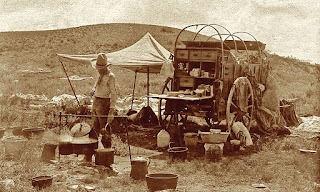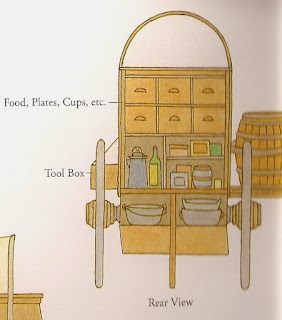As an adjunct to our discussion on campfire cooking, let’s examine that essential piece of cowboy equipment: the chuck wagon. When they think of cowboys, most people imagine the chuck wagon accompanying every trail drive, but that wasn’t always true. The chuck wagon was invented specifically for the use of Texas cowboys in 1866.
While some type of mobile kitchen had existed along the trails for generations, what we now know of as the chuck wagon is attributed to Charles Goodnight, Texas rancher and co-founder of the Goodnight-Loving Trail. The term is attributed to two different sources – one says it was named after “Chuck” Goodnight and the other says it’s from the slang term for food (chuck).
During the early days of the great trail drives, cowboys were responsible for their own meals and had to make do with whatever they could carry with them. This made it tough to recruit good cowboys for long drives to Kansas or other states. Charles Goodnight came up with a solution to this problem and in 1866, created the prototype of the chuck wagon.
Goodnight bought a double army-surplus wagon (Studebaker) and hired a good cook. The two then outfitted the wagon for the trail, adding steel axles that could withstand the tough terrain and boxes, shelves and drawers for the equipment and supplies. Goodnight and his cook created an efficient layout with a “chuck box” (a sloping box with a hinged lid that dropped down to provide a flat working surface) at the back of the wagon. Beneath the wagon was a “boot” to hold larger items like the Dutch oven we talked about in the past few posts.
The average chuck wagon was about ten feet long and 38-40 inches wide. A water barrel and coffee mill were attached to the outside, and a “possum belly” (a strip of canvas or cowhide) was suspended underneath to carry firewood or cow chips. Waterproof tarps were held up by the wagon bows to keep the contents dry, and a “fly,” or canvas awning, was often attached to the top of the chuck box, ready to be rolled out in case of rain.
In the front of some chuck wagons was a “jockey box,” used for storing tools and heavier equipment needed on the trail. Larger ranches might also employ a second wagon to carry the bedrolls, tents, spare saddles and extra supplies. Otherwise, the chuck wagon carried personal items and bedrolls, as well as any other needed supplies (bulk food, water, tools, feed for the horses, medicine, needles and thread, etc.).
The chuck wagon could be drawn by oxen or, more commonly, by mules. Food was usually easy to preserve, such as beans, salted meats, coffee, onions and potatoes, lard, and flour. Beef was easy to come by, and a good cook could prepare many different types, from fried steaks to pot roasts, short ribs and stew.
On long drives (often as much as a thousand miles in length, lasting as long as five months), the cook became one of the most important members of the team – even more so than the drovers themselves. Second only to the Trail Boss, the cook not only made meals, but also acted as barber, dentist and banker. Camp morale also depended on the cook, as well as the smooth functioning of the camp. Even the Trail Boss deferred to the cook at times. The Trail Boss usually made around $100-120 a month and the drovers between $25-40. A good cook made around $60 a month, putting him right up there with the boss in importance.
Cooks usually had a number of nicknames, such as Cookie or Coosie, Soggy, Pot Rustler, Lean Skillet, Old Pud, Old Lady, Belly Cheater, Biscuit Roller, Dough Boxer, Dough Puncher, Greasy Belly, Grub Worm, Gut Robber, Sourdough, and more. Even though some of these names were hardly complimentary, and a chuck wagon cook had a reputation of ill temper, none of the drovers dared to complain. Breakfast and dinner were the highlights of their day. (On the other hand, a cook who didn’t get meals ready on time would quickly be subject to ridicule).
And why was Cookie so ill-tempered? Think of all the extra work he had to do during his day: get up even earlier than the cowboys in order to have breakfast ready, still manage to be alert enough to drive the wagon, be constantly on the look-out for fuel (and gather it), and collect any additional food supplies they might pass along the way. The cook’s day began well before dawn, and after the crew had eaten breakfast and ridden away, he had to wash, dry and put away the dishes and cooking utensils, pack away the bedrolls and any food supplies, then hitch up the team to drive to the next camp. In the evening, he had to move quicker than the crew and be in place with a hot meal when they arrived with the cattle.
If Cookie was feeling kindly towards the cowboys, he might make dessert, usually pastry or pie.
Dinner was the highlight of the cowboy’s day, and though the talk was colorful (and often full of profanity), there were rules to be followed. For instance, never tie a horse to the chuck wagon or ride so close that dust might blow into the food. Approaching riders always stayed downwind from the wagon for the same reason, and cowboys weren’t allowed to scuffle about the camp site. The boys also knew not to play around with the cook – including never touching his tools, never helping himself to a bite before meals, or never using his work table for any reason. Cowboys also never crowded around the cook’s fire for warmth.
More unwritten rules: Never take the last piece of anything unless you’re certain everybody else is finished and if you get up to refill your coffee cup, fill everyone else’s at the same time. After the meal, cowboys always scraped their plates clean and put them into the “wrecking pan” (a big dishpan the cook washed in). After he washed the dishes and cooking utensils, filling the water barrel and dragging up more wood (or cow chips), the cook could finally relax and enjoy what was left of the evening. One trick he used was to point the tongue of the wagon toward due North. When the Trail Boss started out in the morning, he could use the tongue to tell which direction to move the herd.
Here is some chuck wagon etiquette for your cowboys:
· Nobody eats until Cookie calls, then come a-running.
· Fill your plates and move on so someone else can fill theirs.
· Eat first, talk later.
· It’s OK to eat with your fingers – the food’s clean.
· Food left on your plate is an insult to the cook.
· Strangers are always welcome at the wagon.
· If you come across any decent firewood, bring it to the wagon.
Sources:
Legends of America (legendsofamerica.com)
J.E.S. Hays
www.Facebook.com/JESHaysBooks






Another great post. Thanks J.E.S. Hayes
ReplyDeleteGreat post, thanks, JES!
ReplyDeleteFab post. Loved it.
ReplyDeleteThese tidbits of history are so fascinating. Thanks Doris
ReplyDeleteGreat post, JES. I loved it and learned a few things in an entertaining way.
ReplyDeleteThis was so well done. Thank you.
ReplyDeleteExcellent piece
ReplyDelete